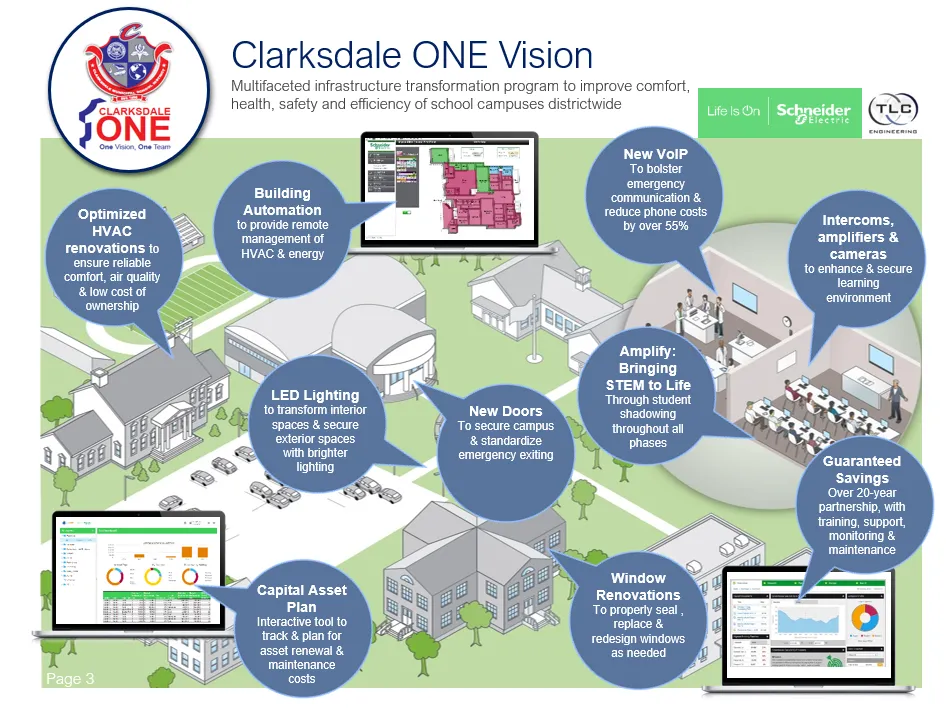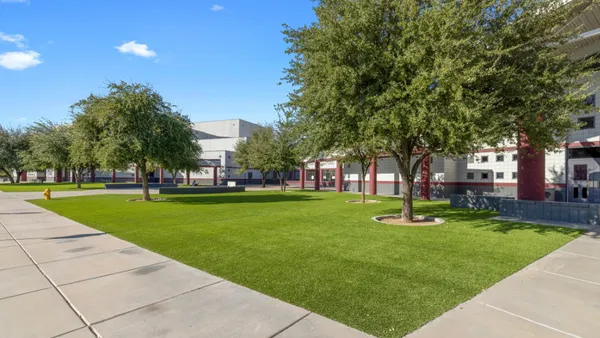When science teacher Joe Greenberg accepted his position at a rural Mississippi school district, his goal was to elevate Clarksdale Municipal School District as a STEM leader and close the educational gap between urban and rural districts. But for this district, the idea of enhanced STEM programming was a new concept. Around them, facilities were aging, with the HVAC system, plumbing, windows and roofs beyond useful lifecycles and diverting funding streams away from curriculum and into operations. It’s a common problem facing America’s educators.
Turning aging facilities into comfortable learning environments
Located in the Mississippi delta, with roughly 2,230 students across nine schools, Clarksdale Municipal School District faced funding challenges in keeping their facilities operational and comfortable. The district passed a bond a few years prior and obtaining the needed taxpayer buy-in to pass another bond for school renovations was unlikely.
The district delayed HVAC and roofing replacements as long as possible, but delaying these projects came with a price tag. The district spent hundreds of thousands of dollars in repairs to these outdated systems over the past few years, just to keep their schools open. In 2020, the district turned to Schneider Electric, energy and sustainability expert, to help modernize their facilities and stabilize their operating budget, without seeking another bond referendum.
With Schneider Electric’s guidance, the district started to develop a multi-phase strategic plan to streamline operations, reduce costs and implement enhanced educational programming.
Alternate funding streams made the impossible, possible

At the same time the district and Schneider Electric assessed capital projects in each facility, the federal government started to disburse much-needed Elementary and Secondary School Emergency Relief Fund (ESSER) dollars. As an underserved district, Clarksdale Municipal School suddenly saw an influx of funds, paired with a long list of needs.
However, one-time formula funds from ESSER were not going to answer for every objective on the list. The Schneider Electric team sought to provide the district with additional funding sources including a wide range of grants, rebates and insurance funding, to strategically piece together their cohesive Clarksdale ONE vision.
The full scope of the Clarksdale ONE project is being implemented in phases, enabling projects to be completed in the order of urgency and importance. Across the first three phases, the district will strategically allocate over $20 million in ESSER funding in a way that will generate nearly $2 million in energy and operational savings, that can be reinvested back into the district.

The Clarksdale ONE Vision includes:
- Upgrades to district-wide telecommunication systems, which provided quick savings and increased security
- Installation of new roofs at six schools strategically funded through insurance
- Implementation of a new security plan and features, which includes cameras, access control measures, new exterior doors and emergency alerts via telecommunication systems
- Delivery of a Capital Asset planning system to accurately track and maintain infrastructure assets, with predictive forecasting for repairs and replacements needed
- Major mechanical upgrades to HVAC systems across the majority of the school district, ensuring better air quality
- Touchless water fixtures such as faucets and toilets and new water fountains with water bottle fillers
- Launch of the AMPLIFY STEM program, with career exploration, hands-on learning and robotics team sponsorship
Partnering for the future of STEM professionals
The building upgrades and new funding streams unlocked the opportunity to reinvest existing budget into student curriculum. With a new operational model and facilities becoming more ideal for learning, Mr. Greenberg was able to bring more to the classroom.
Through their collaboration, a new STEM educational opportunity became a reality. Mr. Greenberg, through the financial support and encouragement of Schneider Electric’s experts, formed one of the Mississippi delta’s first robotics team. In addition, current science classes got a boost through external units provided by Schneider Electric, from solar car racing on Earth Day to guest lectures on alternative energy to mentoring opportunities.
Mr. Greenberg attributes the successful launching of the robotics team to the initial investment in equipment and believes other districts have the ability to achieve the same success if they can cross this first funding barrier. His robotics team went on to compete in a tournament for the first time in 2021, where two students ranked in the top 50, globally, for virtual robotics. This feat helped shine a spotlight on what Mr. Greenberg feels is the gap that exists for his students—the challenge and ambition to master advanced coding and design skills that hadn’t previously been an option.
Clarksdale ONE shows what’s possible
Through the use of alternative funding streams and an energy savings performance contract (ESPC), the district will be able to invest their one-time ESSER stimulus funding into a guaranteed revenue stream and more conducive learning environment to foster student success.
The time to make these large-scale infrastructure upgrades is now. Deadlines for ESSER allocation are approaching and construction projects can have long lead times. Luckily, the Department of Education has just announced that schools may apply for an extension for ESSER III spending for an additional 18 months if they have projects, like capital improvements, that warrant additional time. Many schools are jumping at this opportunity to eliminate a lifetime of deferred maintenance with significant investments in infrastructure.
Learn how districts of all sizes are putting their remaining stimulus dollars to work and making lasting impacts by investing in infrastructure improvements.






 Dive Awards
Dive Awards




